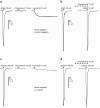GluCl a target of indole alkaloid okaramines: a 25 year enigma solved
- PMID: 25155752
- PMCID: PMC4143795
- DOI: 10.1038/srep06190
GluCl a target of indole alkaloid okaramines: a 25 year enigma solved
Abstract
In 1989, indole alkaloid okaramines isolated from the fermentation products of Penicillium simplicissimum were shown to be insecticidal, yet the mechanism of their toxicity to insects remains unknown. We therefore examined the action of okaramine B on silkworm larval neurons using patch-clamp electrophysiology. Okaramine B induced inward currents which reversed close to the chloride equilibrium potential and were blocked by fipronil. Thus it was tested on the silkworm RDL (resistant-to-dieldrin) γ-aminobutyric-acid-gated chloride channel (GABACl) and a silkworm L-glutamate-gated chloride channel (GluCl) expressed in Xenopus laevis oocytes. Okaramine B activated GluCl, but not RDL. GluCl activation by okaramines correlated with their insecticidal activity, offering a solution to a long-standing enigma concerning their insecticidal actions. Also, unlike ivermectin, okaramine B was inactive at 10 μM on human α1β2γ2 GABACl and α1β glycine-gated chloride channels and provides a new lead for the development of safe insect control chemicals.
Figures




Similar articles
-
Okaramine insecticidal alkaloids show similar activity on both exon 3c and exon 3b variants of glutamate-gated chloride channels of the larval silkworm, Bombyx mori.Neurotoxicology. 2017 May;60:240-244. doi: 10.1016/j.neuro.2016.05.002. Epub 2016 May 3. Neurotoxicology. 2017. PMID: 27153748
-
An L319F mutation in transmembrane region 3 (TM3) selectively reduces sensitivity to okaramine B of the Bombyx mori l-glutamate-gated chloride channel.Biosci Biotechnol Biochem. 2017 Oct;81(10):1861-1867. doi: 10.1080/09168451.2017.1359487. Epub 2017 Aug 21. Biosci Biotechnol Biochem. 2017. PMID: 28825521
-
The fungal alkaloid Okaramine-B activates an L-glutamate-gated chloride channel from Ixodes scapularis, a tick vector of Lyme disease.Int J Parasitol Drugs Drug Resist. 2018 Aug;8(2):350-360. doi: 10.1016/j.ijpddr.2018.06.001. Epub 2018 Jun 4. Int J Parasitol Drugs Drug Resist. 2018. PMID: 29957333 Free PMC article.
-
Okaramines and other plant fungal products as new insecticide leads.Curr Opin Insect Sci. 2018 Dec;30:67-72. doi: 10.1016/j.cois.2018.09.010. Epub 2018 Sep 27. Curr Opin Insect Sci. 2018. PMID: 30553487 Review.
-
Structure, Nuclear Magnetic Resonance Data, Biological Activity, and Synthesis of the Okaramine Family Compounds.J Agric Food Chem. 2025 Jan 15;73(2):985-999. doi: 10.1021/acs.jafc.4c06492. Epub 2025 Jan 6. J Agric Food Chem. 2025. PMID: 39760527 Review.
Cited by
-
Structural Diversity and Biological Activities of the Cyclodipeptides from Fungi.Molecules. 2017 Nov 23;22(12):2026. doi: 10.3390/molecules22122026. Molecules. 2017. PMID: 29168781 Free PMC article. Review.
-
Change the channel: CysLoop receptor antagonists from nature.Pest Manag Sci. 2021 Aug;77(8):3650-3662. doi: 10.1002/ps.6166. Epub 2020 Nov 22. Pest Manag Sci. 2021. PMID: 33135373 Free PMC article. Review.
-
Putative target sites in synganglion for novel ixodid tick control strategies.Ticks Tick Borne Dis. 2023 May;14(3):102123. doi: 10.1016/j.ttbdis.2023.102123. Epub 2023 Jan 19. Ticks Tick Borne Dis. 2023. PMID: 36716581 Free PMC article. Review.
-
Genomic and Comparative Transcriptomic Analyses Reveal Key Genes Associated with the Biosynthesis Regulation of Okaramine B in Penicillium daleae NBP-49626.Int J Mol Sci. 2024 Feb 6;25(4):1965. doi: 10.3390/ijms25041965. Int J Mol Sci. 2024. PMID: 38396642 Free PMC article.
-
Loops D, E and G in the Drosophila Dα1 subunit contribute to high neonicotinoid sensitivity of Dα1-chicken β2 nicotinic acetylcholine receptor.Br J Pharmacol. 2018 Jun;175(11):1999-2012. doi: 10.1111/bph.13914. Epub 2017 Aug 24. Br J Pharmacol. 2018. PMID: 28616862 Free PMC article.
References
-
- Hayashi H., Takiuchi K., Murao S. & Arai M. Structure and insecticidal activity of new indole alkaloids, okaramines A and B, from Penicillium simplicissimum AK-40. Agric Biol Chem 53, 461–469 (1989).
-
- Hayashi H., Fujiwara T., Murao S. & Arai M. Okaramine C, a new insecticidal indole alkaloid from Penicillium simplicissimum. Agric Biol Chem 55, 3135–3145 (1991).
-
- Hayashi H., Asabu Y., Murao S. & Arai M. New okaramine congeners, okaramines D, E, and F, from Penicillium simplicissimum ATCC 90288. Biosci Biotechnol Biochem 59, 246–250 (1995). - PubMed
-
- Hayashi H. & Sakaguchi A. Okaramine G, a new okaramine congener from Penicillium simplicissimum ATCC 90288. Biosci Biotechnol Biochem 62, 804–806 (1998). - PubMed
-
- Shiono Y., Akiyama K. & Hayashi H. New okaramine congeners, okamines J, K, L, M and related compounds, from Penicillium simplicissimum ATCC 90288. Biosci Biotechnol Biochem 63, 1910–1920 (1999). - PubMed
Publication types
MeSH terms
Substances
LinkOut - more resources
Full Text Sources
Other Literature Sources
Miscellaneous

